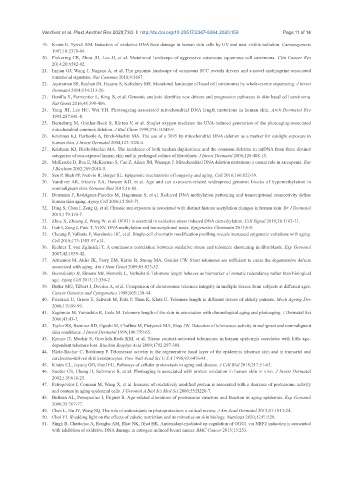Page 747 - Read Online
P. 747
Vandiver et al. Plast Aesthet Res 2020;7:63 I http://dx.doi.org/10.20517/2347-9264.2020.159 Page 11 of 14
19. Kvam E, Tyrrell RM. Induction of oxidative DNA base damage in human skin cells by UV and near visible radiation. Carcinogenesis
1997;18:2379-84.
20. Pickering CR, Zhou JH, Lee JJ, et al. Mutational landscape of aggressive cutaneous squamous cell carcinoma. Clin Cancer Res
2014;20:6582-92.
21. Inman GJ, Wang J, Nagano A, et al. The genomic landscape of cutaneous SCC reveals drivers and a novel azathioprine associated
mutational signature. Nat Commun 2018;9:3667.
22. Jayaraman SS, Rayhan DJ, Hazany S, Kolodney MS. Mutational landscape of basal cell carcinomas by whole-exome sequencing. J Invest
Dermatol 2014;134:213-20.
23. Bonilla X, Parmentier L, King B, et al. Genomic analysis identifies new drivers and progression pathways in skin basal cell carcinoma.
Nat Genet 2016;48:398-406.
24. Yang JH, Lee HC, Wei YH. Photoageing-associated mitochondrial DNA length mutations in human skin. Arch Dermatol Res
1995;287:641-8.
25. Berneburg M, Grether-Beck S, Kürten V, et al. Singlet oxygen mediates the UVA-induced generation of the photoaging-associated
mitochondrial common deletion. J Biol Chem 1999;274:15345-9.
26. Krishnan KJ, Harbottle A, Birch-Machin MA. The use of a 3895 bp mitochondrial DNA deletion as a marker for sunlight exposure in
human skin. J Invest Dermatol 2004;123:1020-4.
27. Krishnan KJ, Birch-Machin MA. The incidence of both tandem duplications and the common deletion in mtDNA from three distinct
categories of sun-exposed human skin and in prolonged culture of fibroblasts. J Invest Dermatol 2006;126:408-15.
28. McKenzie D, Bua E, McKiernan S, Cao Z, Aiken JM, Wanagat J. Mitochondrial DNA deletion mutations: a causal role in sarcopenia. Eur
J Biochem 2002;269:2010-5.
29. Sen P, Shah PP, Nativio R, Berger SL. Epigenetic mechanisms of longevity and aging. Cell 2016;166:822-39.
30. Vandiver AR, Irizarry RA, Hansen KD, et al. Age and sun exposure-related widespread genomic blocks of hypomethylation in
nonmalignant skin. Genome Biol 2015;16:80.
31. Bormann F, Rodríguez-Paredes M, Hagemann S, et al. Reduced DNA methylation patterning and transcriptional connectivity define
human skin aging. Aging Cell 2016;15:563-71.
32. Ding S, Chen J, Zeng Q, et al. Chronic sun exposure is associated with distinct histone acetylation changes in human skin. Br J Dermatol
2018;179:110-7.
33. Zhou X, Zhuang Z, Wang W, et al. OGG1 is essential in oxidative stress induced DNA demethylation. Cell Signal 2016;28:1163-71.
34. Huh I, Zeng J, Park T, Yi SV. DNA methylation and transcriptional noise. Epigenetics Chromatin 2013;6:9.
35. Cheung P, Vallania F, Warsinske HC, et al. Single-cell chromatin modification profiling reveals increased epigenetic variations with aging.
Cell 2018;173:1385-97.e14.
36. Richter T, von Zglinicki T. A continuous correlation between oxidative stress and telomere shortening in fibroblasts. Exp Gerontol
2007;42:1039-42.
37. Armanios M, Alder JK, Parry EM, Karim B, Strong MA, Greider CW. Short telomeres are sufficient to cause the degenerative defects
associated with aging. Am J Hum Genet 2009;85:823-32.
38. Boonekamp JJ, Simons MJ, Hemerik L, Verhulst S. Telomere length behaves as biomarker of somatic redundancy rather than biological
age. Aging Cell 2013;12:330-2.
39. Butler MG, Tilburt J, Devries A, et al. Comparison of chromosome telomere integrity in multiple tissues from subjects at different ages.
Cancer Genetics and Cytogenetics 1998;105:138-44.
40. Friedrich U, Griese E, Schwab M, Fritz P, Thon K, Klotz U. Telomere length in different tissues of elderly patients. Mech Ageing Dev
2000;119:89-99.
41. Sugimoto M, Yamashita R, Ueda M. Telomere length of the skin in association with chronological aging and photoaging. J Dermatol Sci
2006;43:43-7.
42. Taylor RS, Ramirez RD, Ogoshi M, Chaffins M, Piatyszek MA, Shay JW. Detection of telomerase activity in malignant and nonmalignant
skin conditions. J Invest Dermatol 1996;106:759-65.
43. Krunic D, Moshir S, Greulich-Bode KM, et al. Tissue context-activated telomerase in human epidermis correlates with little age-
dependent telomere loss. Biochim Biophys Acta 2009;1792:297-308.
44. Härle-Bachor C, Boukamp P. Telomerase activity in the regenerative basal layer of the epidermis inhuman skin and in immortal and
carcinoma-derived skin keratinocytes. Proc Natl Acad Sci U S A 1996;93:6476-81.
45. Klaips CL, Jayaraj GG, Hartl FU. Pathways of cellular proteostasis in aging and disease. J Cell Biol 2018;217:51-63.
46. Sander CS, Chang H, Salzmann S, et al. Photoaging is associated with protein oxidation in human skin in vivo. J Invest Dermatol
2002;118:618-25.
47. Petropoulos I, Conconi M, Wang X, et al. Increase of oxidatively modified protein is associated with a decrease of proteasome activity
and content in aging epidermal cells. J Gerontol A Biol Sci Med Sci 2000;55:B220-7.
48. Bulteau AL, Petropoulos I, Friguet B. Age-related alterations of proteasome structure and function in aging epidermis. Exp Gerontol
2000;35:767-77.
49. Chen L, Hu JY, Wang SQ. The role of antioxidants in photoprotection: a critical review. J Am Acad Dermatol 2012;67:1013-24.
50. Choi YJ. Shedding light on the effects of calorie restriction and its mimetics on skin biology. Nutrients 2020;12:E1529.
51. Singh B, Chatterjee A, Ronghe AM, Bhat NK, Bhat HK. Antioxidant-mediated up-regulation of OGG1 via NRF2 induction is associated
with inhibition of oxidative DNA damage in estrogen-induced breast cancer. BMC Cancer 2013;13:253.

